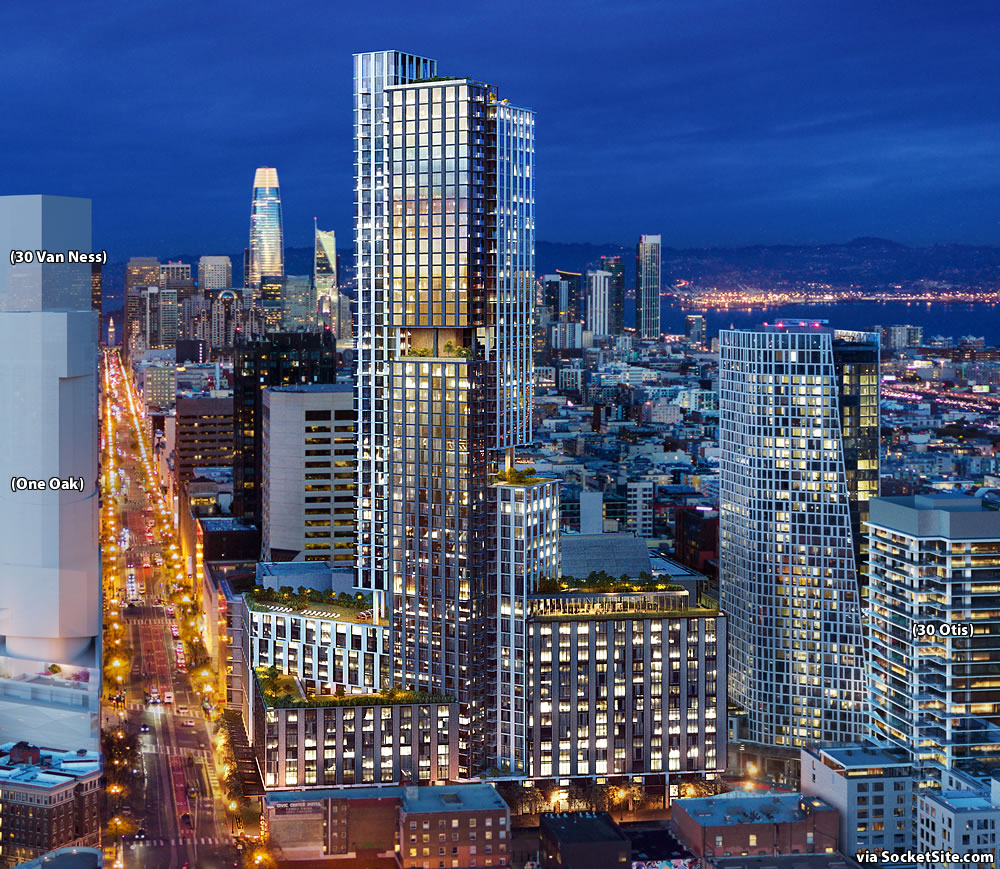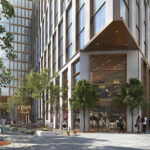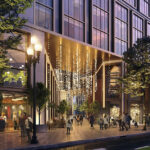As we outlined earlier this year (and since further refined and newly rendered above):
While originally expected to occur last year, the Environmental Impact Report (EIR) for the proposed 55-story tower to rise up to 590 feet in height, not including a 20-foot-tall parapet, on the former San Francisco Honda site at 10 South Van Ness Avenue is now slated to be certified early next month, clearing the way for the project’s approval (assuming the City’s Hub District Plan is approved as well).
Keep in mind that the 10 South Van Ness project was deemed an Environmental Leadership Development Project by Governor Brown back in 2018, a designation which limits the scope and timeline for any EIR-based legal challenges of the project, should they occur.
And as further refined by Kohn Pedersen Fox (KPF) Associates for the Crescent Heights team, the proposed tower would now yield a total of 966 residential units (a mix of 347 studios, 433 one-bedrooms, 165 twos and 21 threes) over 29,400 square feet of new retail and restaurant space, with parking for 261 cars (including 13 retail spaces and 6 car share) and an enclosed mid-block pedestrian connection between Market and 12th Street (the sidewalk for which would be widened and specially paved).
And with the framework for rezoning San Francisco’s 84-acre Hub District having since been approved by Planning, the further refined plans for the proposed 966-unit tower to rise at 10 South Van Ness are slated to be approved by San Francisco’s Planning Commission next week and massed below in context with the other big Hub District projects which are either rising, already approved or on the boards.
And yes, the project team is planning to meet the City’s inclusionary housing requirement for the development by way of a separate land dedication versus including any below market rate (BMR) units on-site and has “engaged with several property owners and are considering several sites to possibly fulfill the requirement, including, but not limited to, a site located at 1979 Mission Street” (a.k.a the beleaguered Monster in the Mission site).




Looks like they removed the bronze accent to the tower facade that was present in previous renderings. That’s a miss.
For over 40 years crossing the bay bridge into the city was always this kind of ritual threshold crossing into a place with its own spirit, and the visuals that always amazed included the view straight up Market Street with Twin Peaks. Now that view has been replaced by looming ugly blocks, that also shroud the Civic Center.
The Hub (Or Century City North) is just another example of how San Francisco is being turned into just another crowded bee hive.
Absurd. San Francisco has always been the most crowded city on the west coast, the view from the bridge has always included tall buildings, and the view up Market to Twin Peaks will not be blocked by these new towers.
Another massive luxury condo development, courtesy of Scott Weiner’s rich YIMBY developers making bucketloads of money. No middle housing, no working class housing, families living in high rise luxury towers? That’s not happening. SF is evolving more and more into a city of rich, luxury tower dwellers and tent camps.
This isn’t just a bad take, it’s a flat out lie. It is intentional disinformation based on a willful misrepresentation of very simple and easy to understand facts. It’s a massive indictment of your position.
For 40 years people like you have been complaining and yet haven’t left, so it can’t be that bad.
Disagree 100%
SF looks 20x better than when I moved here in 2000 and this hub will be a cool addition and no way like century city at all
San Francisco is a CITY. Not a township dedicated to making your memories of looking up a specific street in a specific way ensconced in law.
Bravo! Why stop there? It was even prettier when there wasn’t a city here at all.
Reductio ad absurdum.
The pedestrian experience would be grim indeed if this was allowed to proceed. No change in road layout at a horrible intersection, a cluster of monster blocks on an already windy location – no mitigation for the wind tunnel, no apparent funding for Muni improvements. All this to enable a block of luxury apartments.
These all sound like problems that can be alleviated independently of the buildings, and there is relatively little foot traffic in the area currently.
To be fair there is relatively little foot traffic in the area because the pedestrian environment is terrible in the ways JB laid out.
JB didn’t lay out any ways in which the pedestrian environment is terrible, except to say that it is windy.
Personally, I don’t think there’s anything particularly wrong with the pedestrian environment at that intersection, and I don’t think that whatever undefined issues you are referring to are the reason there is little foot traffic. There’s little foot traffic because there’s not much to draw foot traffic at that intersection. Mostly it’s people going to or from City Hall and the Muni Metro station there. Most of the large employers along that part of Market St. are closer to Civic Center station. One corner of the intersection features a closed-down auto dealer, another a parking lot and a small donut shop. New development there will provide the feet (and the reasons for them) that don’t currently exist.
You can legitimately disagree about the heights proposed here, or the design of the tower, but it’s silliness to suggest that the corner is doomed because it’s windy (and perhaps other reasons that nobody specifies.)
I agree. I used to work right across the street, in 1540 Van Ness. Being in the footprint of One Oak, the rent was cheap since there was a “move out now” clause in the lease. I walked the area every day. While there certainly are pedestrian improvements to be made, it wasn’t bad. A bit of the gritty urban texture that is typical of “real” parts of the city. I think this project will lead to dramatic improvements in the streetscape.
JB mentioned road layout, horrible intersection, and monster blocks. These all lead to a terrible pedestrian environment. Crossing Van Ness means traversing 6 lanes of traffic with no median. Market and Van Ness cross at an angle leading to poor sight lines for walkers and drivers. There are long wait times for pedestrians on exposed corners. The block of Market on the NW corner is devoid of any interest because the large blank wall. All of these contribute to a terrible pedestrian environment and I walked through there 3 or 4 times a week pre-SIP.
New high rise luxury condo development did not activate Eastern SOMA. Why would it anchor Market/Van Ness?
To be fair, there is relatively little foot traffic in the area because the area is terrible. A great place if you’re an urban photographer looking for wasteoids and crazies. Otherwise, there’s nothing there other than play dodge the needle/poop/trash. I’m not sure a bunch of housing towers will change that. Commercial is getting slowly extinguished from SF by market forces. Offices in the area are going all remote (Twitter/Square) or will have other new offices to move to if they choose (Uber/Square).
This plan might have worked in the 40’s or 50’s. It’s 70 years too late.
What’s the problem with wind? It’s not fatal. It’s never freezing cold. It’s just wind.
SFRealist are you serious? The intense wind in the area stinks for the following reasons:
1) Blowing around human/animal fecal matter
2) Doing anything with small children
3) Walk in strong wind is not pleasant day in and day out
4) Is it raining? Is it just mist driven by the wind? Either way it fees like rain
5) Riding a bicycle in a cross/head wind is no fun
6) Step-out balconies or fresh air pop-outs become useless.
Anyone could go on. How can you not see this? Or are you choosing to ignore it just to build more housing?
Is San Francisco the only city on earth where it is sometimes windy? Other people manage. It’s almost too obvious to point out, but Chicago is the Windy City. Chicago also has winter. And yet, the people there survive.
Chicago being called the Windy City has nothing to do with actual Wind.
Yes: supposedly it was do to the puffery of its boosters. So now about that comparison b/w SF and Chicago…
agree it was named after politician windbags, but it is still quite windy near the water. more windy than the Hub area for sure
Also, Chicago has actual winter. People somehow survive.
People tend to avoid living in windy areas if they can, just like they avoid living out in the foggy parts of town. The most laughable part is that Planning thinks that fancy awnings are going to solve the wind problem.
People complained about the wind +/- 50 years ago when the AAA and Fox Plaza buildings went up. It’s in a windy part of town. 2 miles away in my neighborhood – strong winds most every afternoon. I commuted by bike for 20 years. You learn to deal with wind here.
The wind here is incredibly unpleasant at times for walking with strong gusts and shifting directions. It discourages outdoor seating and makes the few outdoor spaces here more difficult to enjoy. The wind is probably 80-90% due to the buildings in the area as nearby streets have much calmer wind speeds.
There’s a Muni Metro station literally underneath and Van Ness BRT will pass through the intersection.
Like there’s so much transit demand from dwellers at Market and Van Ness for transit service up Van Ness.
Nope, the Freeway is 2 blocks away. This is freeway oriented development.
There is a massive overhaul of Market slated around VanNess – Market St. will be narrowed to two lanes, with only passage for Muni, and 50ft sidewalks on either side with cycletracks. It will be one of the later stages of Better Market St, but IIRC, it was approved with the initial stages of the project in october.
There is nothing in any of the plans for celebrating the City’s major intersection in any way other than encrusting it with high rise luxury condos. The only sense of place people will find is a windy place.
The best part about “Better Market Street,” a project in the form of [Comparatively less worse Infrastructure], is that the vaults covering the subway stations were under-engineered for supporting the weight of street cars and buses running on the surface. This is why the pavement over the subway is such crap, especially at the stations. Doing “Better Market Street” on top of this weak foundation means decades and decades of future contracting to be used as chits.
Very excited for this project hope it gets approved and ground breaks ASAP
We might want to consider elevated highways in increasingly dense areas of pedestrians and cars, like the Central Elevated Walkway in HK. Something like this would be amazing for Market street, as it would increase safety and could be cleaned/policed by the retail operators who benefit from it.
Something to at least consider as you could increase the flow of all traffic dramatically.
Or we can just ban cars, like we already did on Market east of Van Ness. It’s a much more pleasant street now without all the idiot drivers there.
Ban cars / severely limit cars in core areas and focus on pedestrian and non motorized transit!!! And expand the subways more! Agreed!
elevated highways?! We just spent the last three decades demolishing elevated highways (Embarcadero and Central) that ran through SF.
Jason made a typo, you can see from his link he is referring to elevated pedestrian walkways, not highways for cars. These types of walkways are often found in cold-weather cities, but they also have them in places like Hong Kong, which is the example from the link.
Elevated pedestrian walkways usually end up killing pedestrian street life below them. See Embarcadero Center.
The city will not be adding any elevated roadways. We are stuck with I-80 as it is part of the interstate system and no one way you could have an at-grade interstate through downtown SF. Other posters have already mentioned, traffic is severely limited on Market St now. All you need to know about the appeal of elevated highways is walk along Division St. Not going to happen.
He meant to say pedestrian walkways, not roadways.
Who gets to decide to demolish a highway? My understanding from the I980 demolition effort from across the bay makes it seem like the city plays a large role.
Yes, it does seem like it, but of course there are state and federal agencies who would need to approve the demolition project’s funding barring some miraculous appearance of municipal funds.
And there’s no need to look at a hypothetical I-980 teardown when one can read about the history of the Embarcadero Freeway right here in S.F (if you weren’t living here at the time, it was torn down thirty years ago).
I’d rather see elevated MUNI trains, but quieter. SF should be modeled after what Taipei has done. Hands down the best public transportation I’ve ever been on and large stretches are above the the streets.
Awesome project!
That whole area will just become a warehouse of sterile high rises for bodies. No charm, no quiet space, no personality, no warm feeling of a neighborhood. Expensive, concrete cracker boxes.
As opposed to its current form, in which its most notable features are an abandoned Honda dealership, a donut shop, a Walgreens, and a Bank of America? Come on.
I live a block away. Sure, street life is lacking, but the eminently pleasant Hayes Valley is just a few blocks’ walk away, within five minutes Muni can take you to Powell, Church Street, or the heart of the Mission. It’s a fantastic place to house bodies for the third of their existence they spend sleeping.
It’s really the most significant intersection in SF; highway 101 at Market Street. It deserves much better than what is there now. A public plaza at the corner. A fountain. Something. Giant building is fine but give something to the street.
Love reading the NIMBY, anti development comments. As a result of this school of thought, it’s no surprise there’s an affordability crisis and massive housing shortage in the Bay Area. More supply like this project will incrementally help the extremely troubling residential supply/demand equation, as well as growing the local tax base, which is dwindling by the day as employers and residents are continuously leaving the Bay Area for cheaper cost metros in Arizona, Nevada, Texas, etc. Will be a benefit to the Bay Area in the long run if this iconic project is built…
The affordability crisis in the Bay Area is a result of lack of homes affordable by people working here at regular income levels derived from jobs that pay salaries not commensurate with the price of real estate, not a lack of new condos that are only affordable to top 1 percenters from Taiwan and Hong Kong and the “Red Nobility” trying to squirrel their wealth out of China.
If this project is built it will not meaningfully help the residential supply/demand balance because the resulting units will not be affordable to the majority of folks currently living here and most of the buyers will not be currently living in the San Francisco. But it will certainly fatten the wallets of the developers, who will be laughing on the way to the bank while their water is being carried by the “useful idiots” that call themselves “YIMBYs” in public comments on this project submitted to the Planning Commission.
The lack of affordable homes is ultimately a supply side issue, as mentioned in my comment, where not enough housing units are being built each year for a multitude of reasons specifically due to the onerous approval process and exorbitantly high “impact fees”. What do you propose as the solution to the affordability crisis in San Francisco? The economics of building a project for middle income renters with “affordable rents” is simply not attainable for most developers because of the cost to build in San Francisco. It’s evident that your attitude towards this project, and building in San Francisco broadly, is a systemic reason behind the affordability crisis we face in San Francisco today. Over time, more supply should lead to more affordable rents, especially if new supply is outpacing demand, which unfortunately won’t be possible because of the lengthy entitlement, zoning and general approval process most developers face. Lower impact fees and passing legislation SB-50 could incrementally help the supply and demand equation, but short sighted and uneducated NIMBY’s are a major part of the problem and reason why we face an affordability crisis today…
As someone who commutes on the Muni Market subway, adding a huge new housing complex right on top of Van Ness station (which I support) is going to pour fire on the overcrowding situation in the subway.
Is there anything new on how to increase capacity in the subway? I’ve heard about 3-car trains on and off for ages and I have ridden a few when they’ve done tests. Do the Siemens LRVs help with this? What other options do we have to streamline subway operations and increase capacity?
Love it. SF needs another district with more high rise buildings.
UPDATE: Timing for Approved 966-Unit Development Pushed Back